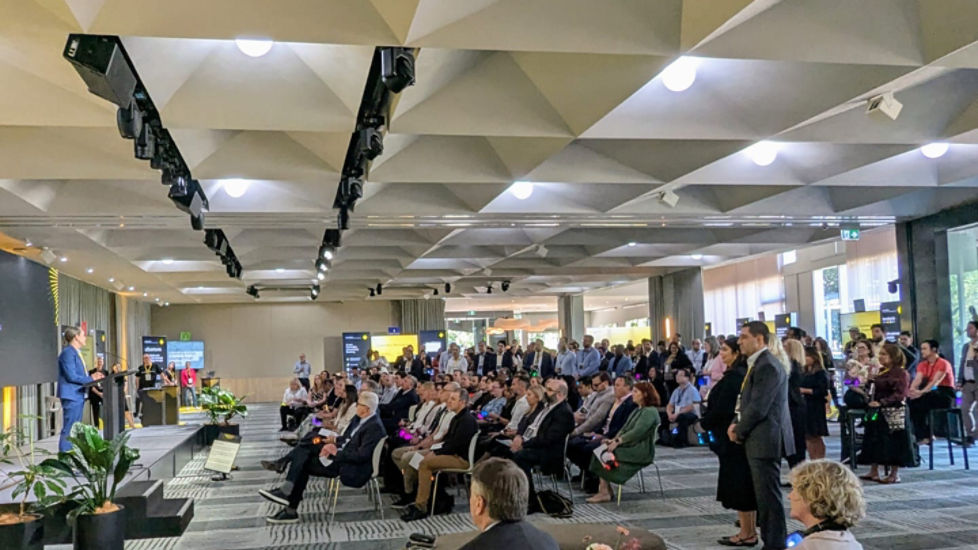From Australia’s first quantum computing start-up to award-winning AI solutions, the CommBank Emerging Technology team has been at the forefront of technology innovation within the financial services industry since 2014. With more than 30 experiments running at any one time, the team’s mission is to unlock the potential of new and emerging technologies by embedding innovation across the organisation, bringing tangible benefits to the Bank and its customers alike.
“I genuinely believe we’re one of the best innovation teams on Earth,” says Jesse Arundell, Head of Emerging Technology. “Our purpose is to accelerate the Bank’s adoption of new and emerging technologies, which is the key to building tomorrow's bank today for our customers.
“To put it simply, we’re a crucible for solving wicked problems inside the Bank with technology.”
Turning innovation into a repeatable process
With a strong focus on collaboration, the team has partnered with thought leaders and innovators across the globe, including Harvard, UTS and several other universities, researchers, technology companies, venture capital firms and start-ups. That enables them to tap into a broader innovation ecosystem and harness the best engineering talent, ideas and technology from all around the world.
“The power of the ecosystem and collaboration cannot be underestimated,” says Arundell.
Along the way, they’ve been recognised with a string of awards, including AFR BOSS magazine's Most Innovative Companies Award (awarded to CommBank for the past nine years), Regtech Innovator of the Year (awarded to CommBank for the past two years), and most recently, IT News Project of the Year.
According to Arundell, one of the keys to the team’s success is a deep conviction that innovation is not a one-off creative act, but a disciplined profession and a business management system within the Bank.
“We’ve designed a repeatable innovation process for the Bank, built on ISO 56002, enabling us to drive outcomes with rigour and discipline, while bringing innovation to life,” he says.
The team draws on the expertise of specialists with a diversity of viewpoints and experience, from data scientists and engineers, to productivity experts such as Six Sigma practitioners. They are also closely connected to CommBank customer-facing teams, helping them to maintain their focus on real-world problems that make a tangible difference to customers.
“Many innovation teams in large enterprises are self-serving,” says Arundell. “To avoid becoming an echo chamber, we operate like a small business within the Bank that serves our internal and external customers. At the same time, we have a lot of independence and freedom to experiment, without the pressure to simply roll out new products or incremental improvements to existing services.”
The power of machine learning
Among other initiatives, the team is applying advanced analytics and machine learning to streamline and automate often complex enterprise processes, freeing staff to focus on customer service.
“We’ve been working on building internal AI products that aim to help the Bank improve its approaches to domains like IT service management, project delivery and cyber security,” Arundell says.
Their successes include the award-winning IT Risk Stability Score, which uses a machine learning model to predict the likelihood of incidents affecting customer-critical systems. Drawing on thousands of service management data points and statistics from incidents over the past three years, the model has measurably improved IT service management.
“It’s a highly predictive capability that allows our service managers to ensure our systems are safe, stable and secure,” Arundell says. “For us, it’s about making our service management practices more proactive and forward looking.”
The result? More resilient, reliable and efficient systems for CommBank customers.
Taking quantum leaps and building digital twins
The team also played a key role in launching Australia’s first quantum computing start-up, Silicon Quantum Computing, with a research grant to the ARC Centre for Quantum Computation and Communication Technology, based at the University of New South Wales.
“Together, we’re working on building the world’s first full-stack quantum computer, which we’ll use to explore a variety of different applications for financial services,” Arundell says. For example, quantum computing has the potential to optimise the Bank’s approach to balancing its portfolios or training machine learning models1.
The team is also breaking new ground in the use of “digital twins”, outside of the realm of creating virtual replicas of physical products, equipment and processes. By building digital versions of the Bank’s internal teams and systems, simulations run over its digital twins can uncover process improvements and pinpoint potential problems before they happen.
“We can use the digital twins to simulate billions of different permutations to help optimise the flow of work,” says Arundell. “That enables us to create ‘prescriptive analytics’ that tell us what might happen and what to do in response.
“We’ve also been experimenting to see how our business customers can use this approach to improve their own processes and systems. The possible applications are extremely varied – supply chain management, for example, or point-of-sale systems.”
As always, collaboration and disciplined creativity are the keys to success.
“The magic comes from finding the link between the best technology being built outside the organisation, and the best ideas from our own people,” Arundell says.




